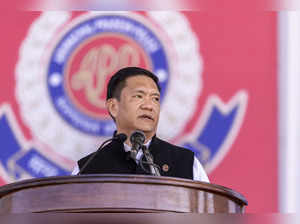 PTI
PTIArunachal Pradesh Chief Minister Pema Khandu said the Siang Upper Multipurpose Project (SUMP), estimated to cost Rs 1.13 lakh crore, was being planned by the Centre not just for generating electricity but to maintain the natural flow of the river all year round and mitigate risks of flooding if China released excess water. Khandu's remarks came in the wake of China approving the construction of the world's largest dam, at a cost of USD 137 billion, on the Brahmaputra river in Tibet close to the Indian border. The dam is to be built at a huge gorge in the Himalayan reaches where the Brahmaputra river makes a huge U-turn to flow into Arunachal Pradesh and then to Bangladesh.
"The SUMP, with an estimated installed capacity of 11,000 mw, is not just about generating power, but also about maintaining the natural flow of the Siang river and mitigating potential flood risks from water releases by China," Khandu told PTI in an interview.
Describing SUMP as a project of national importance, he said hydropower generation is only the secondary goal of it.
"The real objective of the project is to save the Siang river and the communities that have depended on it for generations," he said.
The survey for preparing the pre-feasibility report of the projects is yet to be done amid stiff opposition from locals who are concerned about displacement, loss of livelihoods, and environmental impact of the mega dam.
Warning of severe consequences if China's project moves ahead "without safeguards", Khandu said the neighbouring country's plans to divert water from the Brahmaputra into its arid regions could drastically reduce the flow of the Siang river during winters.
"In such a scenario, the volume of water could decrease so much that one might be able to cross the mighty river on foot," he claimed.
"The proposed Siang project would create a reservoir capable of storing 9 billion cubic meters of water. This would ensure the river maintains a consistent flow, even during dry seasons. Additionally, the reservoir would act as a buffer in case of sudden water releases from upstream Chinese dams, potentially averting catastrophic flooding in Arunachal Pradesh, Assam and Bangladesh," he said.
Acknowledging the ongoing bilateral discussions between India and China, the CM cautioned against "complacency".
"China is unpredictable and can do anything," Khandu said, underscoring the need for India to remain vigilant.
"We cannot take chances when it comes to national security and the welfare of our people," he said.
The Chinese government approved the construction of the hydropower project in the lower reaches of the Yarlung Zangbo river, the Tibetan name for the Brahmaputra. It is expected to generate more than 300 billion kWh of electricity each year - enough to meet the annual needs of over 300 million people.
The total investment in the dam could exceed one trillion yuan (USD 137 billion), which would dwarf any other single infrastructure project on the planet, including China's own Three Gorges Dam, regarded as the largest in the world.
On the concerns of the locals, Khandu said the government would conduct extensive surveys before finalising the plans.
"Only after these studies, we will know the exact location of the dam, its height, and the submergence area," he said, adding that a public hearing will be held to listen to people's concerns.
The CM said India was a democratic country, and it does not believe in "forcing" things on its people.
However, he criticised activists, accusing them of spreading misinformation among villagers about the project.
He claimed that these activists were instigating people without providing accurate information about the project's benefits.
"I urge people to come forward and get their confusions addressed through dialogue," he said.
Khandu also spoke about the state's broader hydropower development plans.
He said the Cabinet Committee on Economic Affairs (CCEA) recently sanctioned Rs 1,750 crore for the 186 mw Tato-I Hydro Electric Project and Rs 1,939 crore for the 240 mw Heo Hydro Electric Project in the Shi Yomi district.
The CM said the state has signed agreements with NHPC, NEEPCO, THDCIL, and SJVN to develop 13 hydropower projects with a combined capacity of over 11,000 mw. Once completed, these projects are expected to generate substantial revenue for the state.
The Centre has also approved a significant equity support scheme to boost hydropower development in the Northeast, he said.
Under this initiative, Rs 4,136 crore has been allocated to northeastern states to develop hydroelectric projects with a cumulative capacity of 15,000 mw by 2032.
"This initiative will transform the hydroelectric landscape of Arunachal Pradesh and the northeast region," Khandu said, adding the Centre has also agreed to increase the Local Area Development Fund (LADF) contribution from power projects to over 2 per cent.
"We are taking steps to ensure that Arunachal Pradesh becomes a powerhouse for the nation while protecting the interests of our people and environment," he added.
ET Year-end Special Reads
Describing SUMP as a project of national importance, he said hydropower generation is only the secondary goal of it.
"The real objective of the project is to save the Siang river and the communities that have depended on it for generations," he said.
The survey for preparing the pre-feasibility report of the projects is yet to be done amid stiff opposition from locals who are concerned about displacement, loss of livelihoods, and environmental impact of the mega dam.
Warning of severe consequences if China's project moves ahead "without safeguards", Khandu said the neighbouring country's plans to divert water from the Brahmaputra into its arid regions could drastically reduce the flow of the Siang river during winters.
"In such a scenario, the volume of water could decrease so much that one might be able to cross the mighty river on foot," he claimed.
"The proposed Siang project would create a reservoir capable of storing 9 billion cubic meters of water. This would ensure the river maintains a consistent flow, even during dry seasons. Additionally, the reservoir would act as a buffer in case of sudden water releases from upstream Chinese dams, potentially averting catastrophic flooding in Arunachal Pradesh, Assam and Bangladesh," he said.
Acknowledging the ongoing bilateral discussions between India and China, the CM cautioned against "complacency".
"China is unpredictable and can do anything," Khandu said, underscoring the need for India to remain vigilant.
"We cannot take chances when it comes to national security and the welfare of our people," he said.
The Chinese government approved the construction of the hydropower project in the lower reaches of the Yarlung Zangbo river, the Tibetan name for the Brahmaputra. It is expected to generate more than 300 billion kWh of electricity each year - enough to meet the annual needs of over 300 million people.
The total investment in the dam could exceed one trillion yuan (USD 137 billion), which would dwarf any other single infrastructure project on the planet, including China's own Three Gorges Dam, regarded as the largest in the world.
On the concerns of the locals, Khandu said the government would conduct extensive surveys before finalising the plans.
"Only after these studies, we will know the exact location of the dam, its height, and the submergence area," he said, adding that a public hearing will be held to listen to people's concerns.
The CM said India was a democratic country, and it does not believe in "forcing" things on its people.
However, he criticised activists, accusing them of spreading misinformation among villagers about the project.
He claimed that these activists were instigating people without providing accurate information about the project's benefits.
"I urge people to come forward and get their confusions addressed through dialogue," he said.
Khandu also spoke about the state's broader hydropower development plans.
He said the Cabinet Committee on Economic Affairs (CCEA) recently sanctioned Rs 1,750 crore for the 186 mw Tato-I Hydro Electric Project and Rs 1,939 crore for the 240 mw Heo Hydro Electric Project in the Shi Yomi district.
The CM said the state has signed agreements with NHPC, NEEPCO, THDCIL, and SJVN to develop 13 hydropower projects with a combined capacity of over 11,000 mw. Once completed, these projects are expected to generate substantial revenue for the state.
The Centre has also approved a significant equity support scheme to boost hydropower development in the Northeast, he said.
Under this initiative, Rs 4,136 crore has been allocated to northeastern states to develop hydroelectric projects with a cumulative capacity of 15,000 mw by 2032.
"This initiative will transform the hydroelectric landscape of Arunachal Pradesh and the northeast region," Khandu said, adding the Centre has also agreed to increase the Local Area Development Fund (LADF) contribution from power projects to over 2 per cent.
"We are taking steps to ensure that Arunachal Pradesh becomes a powerhouse for the nation while protecting the interests of our people and environment," he added.
(Catch all the Business News, Breaking News, Budget 2024 Events and Latest News Updates on The Economic Times.)
Subscribe to The Economic Times Prime and read the ET ePaper online.
Read More News on
(Catch all the Business News, Breaking News, Budget 2024 Events and Latest News Updates on The Economic Times.)
Subscribe to The Economic Times Prime and read the ET ePaper online.





































